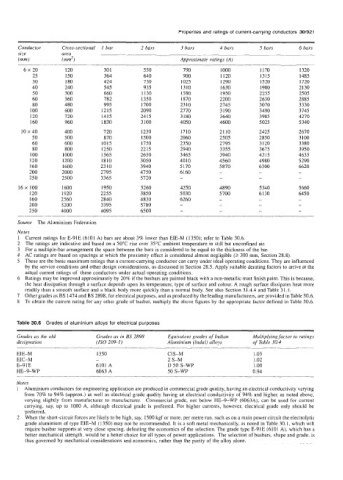Page 973 - Industrial Power Engineering and Applications Handbook
P. 973
Properties and ratings of current-carrying conductors 30/921
Conductor Cross-sectional I bar 2 bars 3 bars 4 bars 5 bars 6 bars
size area
(mm) (mm2) Approximate ratings (A)
6 x 20 120 30 1 550 790 lo00 1170 1320
25 150 364 640 900 1120 1315 1485
30 180 424 730 1025 1290 1520 1720
40 240 545 935 1310 1630 1900 2130
50 300 660 1130 1580 1950 2255 2505
60 360 782 1350 1870 2200 2630 2885
80 480 995 1700 2310 2745 3070 3330
100 600 1215 2090 2770 3190 3490 3745
120 720 1415 2415 3180 3640 3985 4270
160 960 1830 3100 4050 4600 5025 5340
10 x 40 400 720 1230 1710 2110 2425 2670
50 500 870 1500 2060 2505 2850 3100
60 600 1015 1750 2350 2795 3120 3380
80 800 1250 2215 2940 3355 3675 3950
100 1000 1565 2650 3465 3940 4315 4635
120 1200 1810 3050 4010 4560 4980 5290
160 1600 2310 3940 5170 5870 6300 6620
200 2000 2795 4750 6160 - - -
250 2500 3365 5720 - - - -
16 x 100 1600 1950 3260 4250 4890 5340 5660
120 1920 2255 3850 5030 5700 6130 6450
160 2560 2840 4830 6260 - - -
200 3200 3395 5780 - - - -
250 4000 4095 6500 - - - -
Source The Aluminium Federation
Notes
1 Current ratings for E-91E (6101 A) bars are about 3% lower than EIE-M (1350); refer to Table 30.6.
2 The ratings are indicative and based on a 50°C rise over 35°C ambient temperature in still but unconfined air.
3 For a multiple-bar arrangement the space between the bars is considered to be equal to the thickness of the bar.
4 AC ratings are based on spacings at which the proximity effect is considered almost negligible (2 300 mm, Section 28.8).
5 These are the basic maximum ratings that a current-canying conductor can carry under ideal operating conditions. They are influenced
by the service conditions and other design considerations, as discussed in Section 28.5. Apply suitable derating factors to arrive at the
actual current ratings of these conductors under actual operating conditions.
6 Ratings may be improved approximately by 20% if the busbars are painted black with a non-metallic matt finish paint. This is because,
the heat dissipation through a surface depends upon its temperature, type of surface and colour. A rough surface dissipates heat more
readily than a smooth surface and a black body more quickly than a normal body. See also Section 3 1.4.4 and Table 3 1.1.
7 Other grades as BS 1474 and BS 2898, for electrical purposes, and as produced by the leading manufacturers, are provided in Table 30.6.
8 To obtain the current rating for any other grade of busbar, multiply the above figures by the appropriate factor defined in Table 30.6.
Table 30.6 Grades of aluminium alloys for electrical purposes
Grades as the old Grades as in BS 2898 Equivalent grades of Indian Multiplying factor to ratings
designation (IS0 209-1) Aluminium (Indal) alloys of Table 30.4
EIE-M 1350 CIS-M 1.03
EIC-M - 2 S-M 1.02
E91E 6101 A D 50 S-WP 1 .oo
HE-9-WP 6063 A 50 S-WP 0.94
Notes
1 Aluminium conductors for engineering application are produced in commercial grade quality, having an electrical conductivity varying
from 70% to 94% (approx.) as well as electrical grade quality having an electrical conductivity of 94% and higher, as noted above,
varying slightly from manufacturer to manufacturer. Commercial grade, not below HE-9-WP (6063A), can be used for current
carrying, say, up to 1000 A, although electrical grade is preferred. For higher currents, however, electrical grade only should be
preferred.
2 When the short-circuit forces are likely to be high, say, 1500 kgf or more, per metre run, such as on a main power circuit the electrolytic
grade aluminium of type EIE-M (1350) may not be recommended. It is a soft metal mechanically, as noted in Table 30.1, which will
require busbar supports at very close spacing, defeating the economics of the selection. The grade type E-91E (6101 A), which has a
better mechanical strength, would be a better choice for all types of power applications. The selection of busbars, shape and grade, is
thus governed by mechanical considerations and economics, rather than the purity of the alloy alone.

